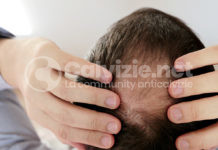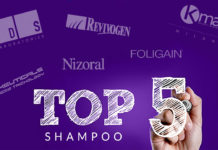Title: Prostaglandin analogs for hair growth: Great expectations
Author: Ronni Wolf MD1, Hagit Matz MD1,2, Miriam Zalish3, Ayala Pollack MD3, Edith Orion MD1
Dermatology Online Journal 9(3): 7
1. The Dermatology Unit, Kaplan Medical Center, Rechovot 2. The
Department of Dermatology, Tel-Aviv Sourasky Medical Center, Tel-Aviv 3.
The Department of Ophthalmology, Kaplan Medical Center, Rechovot, Israel.
Abstract
Latanoprost, a prostaglandin analog, has been reported to stimulate eyelash growth in patients using it in eye preparations for glaucoma and
body and scalp hair growth when used topically in various animal models.
Will prostaglandin analogs be the next agents used for forms of alopecia?
Shortly after the introduction of a prostaglandin analog, latanoprost (Xalatan®), as an intraocular pressure (IOP)-lowering drug for use in
patients with glaucoma and ocular hypertension, the stimulating effect of this drug on eyebrow and eyelash hair growth and pigmentation was
reported in an ophthalmology journal. <1> As when minoxidil appeared, physicians, researchers, pharmaceutical companies, and hair-challenged lay people the world over built up hopes that lightning had struck again and that latanoprost’s hair-growing capabilities would be useful for treatment of baldness. Perhaps a family of similar chemicals would become new, effective hair-promoting drugs. Latanoprost is familiar to ophthalmologists colleagues because of its utility for the treatment of glaucoma, but dermatologists lag behind in understanding the effects of this new class of drugs. This paper is an update on this hot topic.
Clinical and observational studies
Latanoprost was first documented as a hair-growth stimulant by Johnstone in 1997. Aware of this nonocular effect of the drug, he looked for evidence of hypertrichosis and pigmentation of eyelashes among 43 patients who were using unilateral topical latanoprost for glaucoma.
Hypertrichosis was evaluated in the ipsilateral terminal and regional intermediate hairs of the upper and lower eyelids as well as vellus hair of the lower eyelid skin. There was a mean increase in lash length of the lower eyelid of 19.5 percent in the latanoprost-treated eye (range, 0%-36%). The two patients who had no measurable eyelash-length change exhibited an increase in the number of eyelashes.
Differences in hair appearance between the latanoprost-treated eye and the nontreated control eye included increased number, length, thickness, curvature, and pigmentation.
Several additional case reports of hypertrichosis and darkening of eyelashes in patients treated with latanoprost have appeared.
A representative case involved a 53-year-old woman who suffered from glaucoma and total loss of the eyelashes in both her eyes as well as diffuse scalp hair thinning after an allergic response to ibuprofen.
She experienced a regrowth of all her eyelashes after 2 months of treatment with latanoprost.
Several subsequent studies that aimed to evaluate the effect of prostaglandin analogs on IOP also mention the side-effects of hypertrichosis and increased pigmentation of eyelashes.
In one study, changes in eyelash characteristics, including length, thickness, density, and color, were recorded in as many as 57 percent of treated patients.
Three recent controlled studies that were specifically designed to evaluate quantitatively the apparent eyelash-lengthening effect of
latanoprost yielded contradictory results. In one of them, seventeen patients with glaucoma or ocular hypertension were treated with
latanoprost in one eye.
The mean eyelash length for the treated eye was 5.8 mm at baseline, 6.5 mm at 2 weeks, 6.5 mm at 6 weeks, and 6.6 mm at 10 weeks. The corresponding differences for the untreated eyes were nonsignificant (5.7 mm, 5.8 mm, 5.9 mm, and 5.6 mm, respectively).
The authors’ conclusion was that latanoprost significantly increases eyelash length.
In a modest prospective study of seven patients treated with latanoprost for a minimum of 5 months, lash length was assessed using a
digital imaging technique.
Only one patient showed longer lashes, and there were thicker lashes in ten of the fourteen examined eyes. In
the third analysis, 44 patients affected by IOP were divided into two groups, one treated with latanoprost and the other with timolol (control
group).
Although the latanoprost-treated patients showed a slight tendency toward an increase in eyelash length (mean of 0.2 mm) at the 6-month checkup, this effect was not statistically significant; it was aesthetically evident in only 7 percent of the treated subjects.
Finally, even the most ardent supporters of the hair-growth potential of PG analogs would probably agree that the results of Johnstone’s study, presented at the annual meeting of the Association for Research in Vision and Ophthalmology in 1998 were very unexpected and simply too
good to be true. In reviewing the records and photographs of 89 glaucoma patients with hypertrichosis following unilateral treatment with topical latanoprost, he found five patients who had been treated for only a brief interval (less than 3 weeks) who showed increased number, length, thickness, and pigmentation of lashes similar to others who had undergone sustained treatment.
Furthermore, these changes persisted in varying degrees for up to 14 months, the duration of the followup interval.
Experimental studies
Perhaps the most relevant study on the effect of latanoprost on scalp hair growth is the one by Uno et al. who used a macaque model of androgenetic alopecia. <19> The results of this well-controlled study (8 monkeys, 4 treated and 4 serving as controls) showed that treatment with 50 mcg/ml latanoprost daily over 5 months caused minimal hair growth, whereas 500 mcg/ml daily over 3 months induced moderate-to-marked hair regrowth. A 5-10 percent rate of conversion of vellus hairs to intermediary or terminal hairs was observed. The vehicle group showed no effect. Stjernschantz found a significant hypertrichotic effect of a selective prostanoid receptor agonist (fluprostenol) on hair growth as determined by measuring the rate of the regrowth of fur in adult male CBA-J mice.
Speculating that activation of prostaglandin-H synthase (PGHS)-1 might be the mechanism by which minoxidil stimulates hair growth in vivo,
Michelet et al. demonstrated that minoxidil is indeed a potent activator of purified PGHS-1, by assaying oxygen consumption and prostaglandin (PG)E2 production.
This activation was also evidenced by increased PGE2 production by BALB/c 3T3 fibroblasts and by human dermal papilla fibroblasts in culture. These findings suggest that the mechanism behind the hair-growth-stimulating effect of minoxidil is stimulation of PGE2 synthesis. If this conclusion were the case, it would stand to reason that other, more specific, PG activators (PG analogs) might show even better results.
Several studies performed before the introduction of prostaglandin analogs for the treatment of IOP showed that both systemic and topical
application of PGE2 resulted in a significant degree of protection against radiation-, or doxorubicin-induced alopecia.
In a more recent study, prostaglandin receptor (EP)3 and EP4 mRNA were expressed in the dermal papilla cells and the outer-root-sheath cells located in the hair bulb region, respectively, in 3-week-old mouse dorsal skin (in the anagen phase). In 8-week hair follicles (in the
telogen phase), the signals for both EP3 and EP4 mRNA had disappeared. On days 8 and 12 after depilation, EP3 and EP4 mRNA were reexpressed, and induction of cyclooxygenase (COX)-2 mRNA was also observed, suggesting that PG receptors are involved in the evelopment and regrowth of the hair follicles.
Two studies using transgenic mice with overexpression of COX-2 in the skin showed directly contradictory results.Transgenic mice under
the control of a bovine keratin 5 (K5) promoter and human keratin 14 promoter and overexpressing COX-2 in both the basal cells of the interfollicular epidermis and the pilosebaceous unit, exhibited reduced hair-follicle density and delayed postnatal hair follicle morphogenesis
compared with wild-type animals. Administration of a specific COX-2 inhibitor (in one experiment) restored hair growth, indicating that
the alopecia was attributable to elevated COX-2 enzymatic activity.
Our prediction for the future
Although “it’s tough to make predictions, especially about the future” (Yogi Berra of baseball fame), and although physicians and scientists
find it hazardous to peer into a crystal ball, we are game to accept the challenge.
Even though scalp hair follicles and eyelash follicles are not identical, and one cannot simply extrapolate from a drug’s effect on one
type of hair to another, we believe that a powerful hair stimulant that acts on one type of hair should act on other types as well.
Several of the above-mentioned experimental studies support the stimulating effects of PG analogs on hairs other than eyelashes (i.e., scalp hair and body fur). Furthermore, if the proposed mechanism of minoxidil action is indeed through its stimulating effect of PGE2 synthesis, then one should ask why we need to stimulate the synthesis of PG if we can use it directly? Minoxidil (which has been used by women to thicken their
eyelashes and to treat alopecia areata of this area) showed inferior results on eyelash growth than those described for latanoprost.
Minoxidil and finasteride must be used continuously to sustain results, and, once discontinued, the natural balding process resumes. PG analogs
have a much more powerful and longer-lasting effect.
Although we do not think that PG analogs are likely to emerge as the panacea for androgenetic alopecia, we strongly believe that they are
excellent candidates to become the first drugs of choice for this affliction by achieving greater therapeutic success than other currently
available preparations. Because it is highly unlikely that dermatologists encounter the effect of eyedrops on eyelash growth, and
because most of the relevant literature appears in ophthalmological journals, most dermatologists know all too little about the promising
effects of these new drugs. We hope that this attempt to enlighten our colleagues about these findings stimulates new lines of investigation
that will reliably stimulate new and lasting hair growth.






























